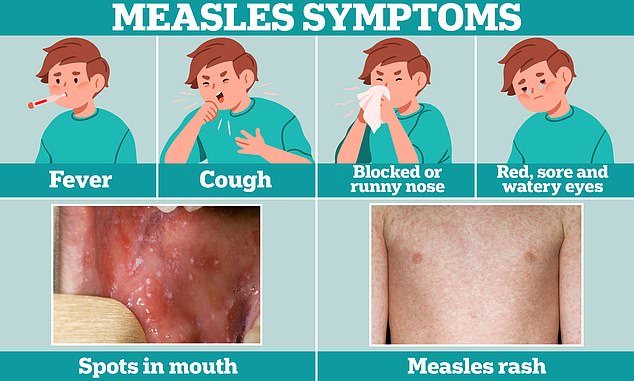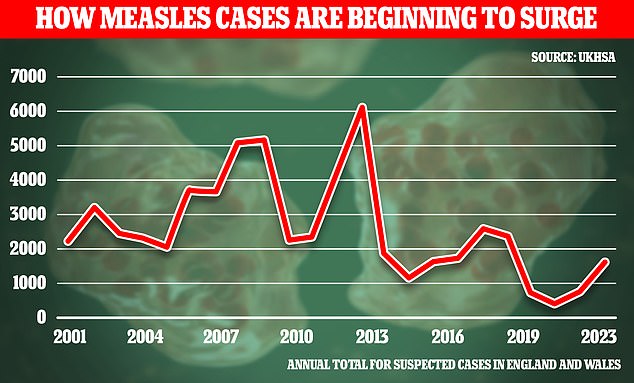Top expert warns parents of earliest and little-known sign of measles that is ‘often overlooked’ – ahead of return to ‘super-spreading’ classrooms
Most people recognize a rash as the first sign of measles, but experts say there are several other symptoms that can appear days before.
But some of these symptoms, such as sneezing, coughing and aches, can easily be mistaken for a cold or flu.
According to experts, there is one warning sign that parents should watch out for: it is almost always a sign that it is measles.
The virus causes small, white spots on the inside of the cheek that look like ‘grains of sand’, but are often overlooked, said Helen Bedford, professor of child health at the Great Ormond Street Institute of Child Health.
She told MailOnline that they are called Koplik spots and can appear on the inside of the cheeks and at the back of the lips. They are usually around 1 to 3mm in diameter.
One of the first warning signs that is often overlooked is small white spots on the inside of the cheek
Experts are now warning parents of the early warning signs to prevent outbreaks of the virus that are spreading “like wildfire.”
Research shows that measles can be fatal. About three out of every 1,000 children who get the disease die from it.
Complications include blindness, deafness, and swelling of the brain (encephalitis).
It is one of the most contagious pathogens known to man and can be spread through the coughing and sneezing of an infected person.
Symptoms include sneezing, coughing, aches and pains, and the measles rash. However, the virus can also lead to serious complications, such as pneumonia and meningitis.
Another sign of measles is the rash. This usually starts on the face and behind the ears and then spreads to the rest of the body.
The spots that make up the rash may be raised and merge into blotchy patches.
But unlike chickenpox, this rash usually does not itch.
On white skin, the rash appears red or brown, but it can be harder to see on brown and black skin, according to the NHS.

Cold-like symptoms, such as fever, cough, and a runny or stuffy nose, are usually the first sign of measles. A few days later, some people develop small white spots on the inside of their cheeks and the backs of their lips. The characteristic measles rash also develops, usually starting on the face and behind the ears before spreading to the rest of the body

The latest data from the UK Health Security Agency (UKHSA) shows that there were 1,603 suspected measles cases in England and Wales in 2023. The number is more than double the 735 recorded in 2022 and an almost five-fold increase on the 360 cases reported in 2021.
Earlier this year, the UK Health Security Agency (UKHSA) announced that the number of measles cases was increasing.
The UK has seen its biggest measles outbreak in 10 years, with the number of cases in February exceeding the last major outbreak in 2013.
Analysis shows that if just one child in a classroom is infected, he or she can pass the virus on to up to nine other unvaccinated children, making it one of the most contagious diseases in the world, more contagious than Covid.
‘If a child has measles, it is better for parents to call the doctor straight away than to take their child to the GP, because measles is highly contagious and spreads very quickly,’ said Professor Bedford.
In the absence of treatment, the best approach is defense in the form of the highly contagious measles, mumps, and rubella (MMR) vaccine.
Two doses of the MMR vaccine, given at one year of age and then at three years and four months of age, provide lifelong protection.
After both doses, 99 percent of people are protected against measles.
In January, the NHS launched a catch-up campaign with pop-up clinics in schools and letters sent to millions of people, in the hope of increasing vaccination rates.
Steve Russell, NHS director of vaccinations and screening, said: ‘People who have not been vaccinated can get a catch-up vaccination at MMR vaccination points in schools and other convenient places, while GPs, teachers and trusted community leaders are encouraging groups who are less likely to be vaccinated to come forward.’
But it is never too late to get the shot. People who missed their vaccination can schedule a catch-up vaccination at any time by contacting their GP.
‘The most important thing is to get children vaccinated. Some people think their child is past the recommended vaccination age, but it is never too late. You can get the vaccine as an adult,’ added Professor Bedford.
